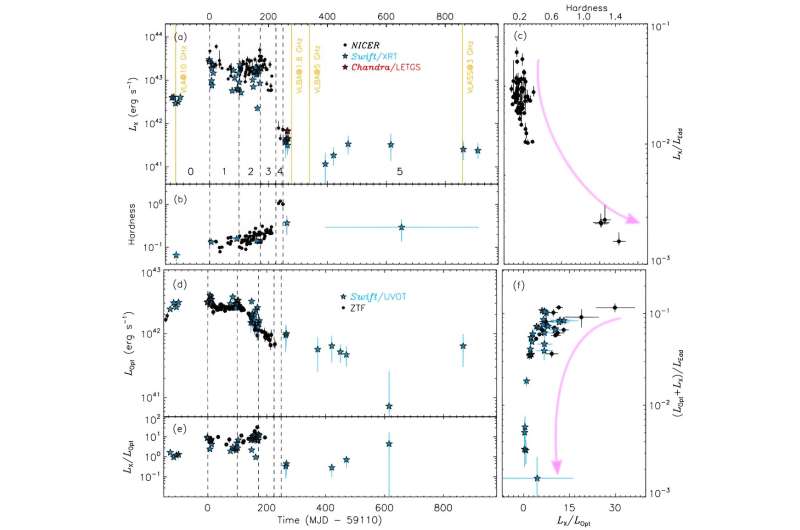December 27, 2023 report
This article has been reviewed according to Science X's editorial process and policies. Editors have highlighted the following attributes while ensuring the content's credibility:
fact-checked
preprint
trusted source
proofread
Astronomers inspect a peculiar nuclear transient

An international team of astronomers has employed a set of space telescopes to observe a peculiar nuclear transient known as AT 2019avd. Results of the observational campaign, presented in a paper published December 21 on the pre-print server arXiv, deliver important insights into the properties and behavior of this transient.
Nuclear astrophysics is key to understanding supernova explosions, and in particular the synthesis of the chemical elements that evolved after the Big Bang. Therefore, detecting and investigating nuclear transient events could be essential in order to advance our knowledge in this field.
At a redshift of 0.028, AT 2019avd is a peculiar nuclear transient discovered by the Zwicky Transient Facility (ZTF) in 2009. The transient has been detected in various wavelengths, from radio to soft X-rays, and has recently exhibited two continuous flaring episodes with different profiles, spanning over two years.
Previous studies of AT 2019avd have suggested, based on its ultra-soft X-ray spectrum and optical spectral lines, that it may be a tidal disruption event (TDE). In general, TDEs occur when a star passes close enough to a supermassive black hole and is pulled apart by the black hole's tidal forces, causing the process of disruption. However, two optical flares observed from this transient turned out to be atypical for TDEs.
In order to determine the true nature of AT 2019avd, a team of astronomers led by Yanan Wang of the Chinese Academy of Sciences, has employed NASA's Swift and Chandra spacecraft, as well as the Neutron star Interior Composition Explorer (NICER) onboard the International Space Station (ISS) to perform a monitoring campaign of this transient spanning more than 1,000 days.
The observations of AT 2019avd have found that it exhibits high X-ray variability on both short (lasting from hundreds to thousands of seconds) and long (years) timescales. Moreover, the monitoring campaign revealed some unique properties of this transient.
First of all, a rapid drop in luminosity of AT 2019avd occurred approximately 225 days following the peak of X-ray emission, which exceeded two orders of magnitude. This drop in luminosity was accompanied by X-ray spectral hardening and was followed by the possible ejection of an optically-thick radio outflow.
The observations found a softer-when-brighter relation throughout the flare as the spectrum hardens as the luminosity decreases. It was also found that when the luminosity decreases by over one magnitude, the blackbody temperature remains constant and the photon index decreases with the luminosity.
According to the study, the fractional root-mean-square (rms) amplitude of the detected X-ray variability is high with an average of 43% and its evolution is related to spectral state. The astronomers assume that the variability may be attributed to some intervening clumpy outflows.
The authors of the paper noted that the obtained results do not allow them to draw final conclusions on the TDE nature of AT 2019avd. They plan further monitoring of this transient in order to see whether it will eventually evolve to the standard hard state and how long it will take to draw a full evolution of the accretion process.
More information: Yanan Wang et al, Rapid dimming followed by a state transition: a study of the highly variable nuclear transient AT 2019avd over 1000+ days, arXiv (2023). DOI: 10.48550/arxiv.2312.13543
Journal information: arXiv
© 2023 Science X Network





















